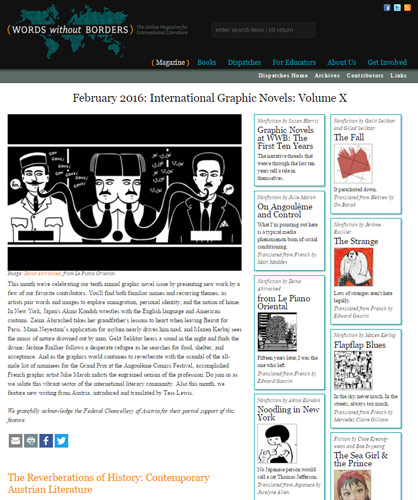Words Without Borders – February 2016
For ten years, Words Without Borders has been publishing an annual graphic novel issue each February. According to Editorial Director Susan Harris in “Graphic Novels at WWB: The First Ten Years,” this issue brings the amount of graphic works on the site to a whopping 174. A link to the entire graphic archive is provided, and after reading this issue, readers won’t be able to resist diving in. For ten years, Words Without Borders has been publishing an annual graphic novel issue each February. According to Editorial Director Susan Harris in “Graphic Novels at WWB: The First Ten Years,” this issue brings the amount of graphic works on the site to a whopping 174. A link to the entire graphic archive is provided, and after reading this issue, readers won’t be able to resist diving in.
A twelve-page excerpt from Mana Neyestani’s A Short Guide to Being the Perfect Political Refugee is included in this issue. Ten years ago, Neyestani’s use of an Azeri word for “cockroach” in a children’s cartoon triggered riots, resulting in Neyestani’s imprisonment and then emigration, eventually to Paris. His excerpt takes place inside a Paris police station on days when refugees are able to come in and apply for identification. He demonstrates biting wit: “A real refugee could have foreseen the arrival of this day when he would file for asylum in France when still a child and would have endeavored to learn French,” and the emotive faces of his characters are absorbing. Readers can tell exactly how each is character feeling, allowing us to sympathize and sink into a setting that many of us are unaware of.
An issue on graphic literature would be incomplete without bringing up the Angoulême International Comics Festival and the controversy that surrounded it this past January with a continuing lack of woman jurors, an all-male selection of thirty for this year’s Grand Prix nominees, and excuses that women comic artists are hard to come by—a statement easily argued against. Julie Maroh covers the Festival in “On Angoulême and Control,” providing necessary background information and lending analysis on the subsequent response to the nominee list. When some of the thirty men pulled their names from the list, they were lauded by media. But when women speak out, Maroh predicts from experience: “we’ll be easily dismissed as whiny hags with nothing better to do, or who need to get laid,” while a man “is seen as a knight coming to rescue the princess.” The controversy bares the sexism that reigns within the world of comics, and Maroh writes about it succinctly, getting right to the point while providing enough information for newcomers to the issue to feel interested and invested.
While representation is lacking elsewhere in the community, Words Without Borders does their share to include a diverse selection of comic artists this issue from Japan’s Akino Kondoh with her selection “Noodling in New York” which reads right to left like traditional manga, to an excerpt from the autobiographical Le Oriental Piano by Lebanese Zeina Abirached whose whimsical art readers may recognize after the publication of her 2012 young adult graphic memoir A Game for Swallows, art identifiable by a use of thick black lines and backgrounds, her curlicue hair-dos, and owlish eyes. Jérôme Ruillier’s “The Strange,” translated by Edward Gauvin, almost looks as if it was made for or by children, the characters drawn as animals and crayon scribbles the medium of choice, but tackles the heavy topics of being an unwanted outsider, a foreigner, a strange presence in a new place.
Even North Korea makes an appearance in this issue with “The Sea Girl & the Prince” by Chae Kyeong-weon and Bae In-yeong, translated by Bella Dalton-Fenkl. Written by North Korean writers, this romantic graphic narrative shows unification between North and South Korea in the marriage of a diver and a prince. Words Without Borders does a fantastic job of collating a varied selection of graphic work from all over the world, giving readers a chance to check out work by writers they may never have stumbled upon themselves.
Beyond graphic literature, this issue also takes readers to Austria for a selection of new Austrian literature, translated and curated by Tess Lewis who opens the section with an essay about her selections. The writing in this section like Maja Haderlap’s poetry, exploring the borders of language and of identity, is sure to satisfy even the readers that are just tuning in for the graphic work.
With 174 pieces of graphic literature collected over the years, Words Without Borders takes readers to unfamiliar places and opens the door to writing not found anywhere else.
[www.wordswithoutborders.org]






